Pumping Station Desing - Second Edition by Robert L. Sanks, George Tchobahoglous, Garr M. Jones
Подождите немного. Документ загружается.

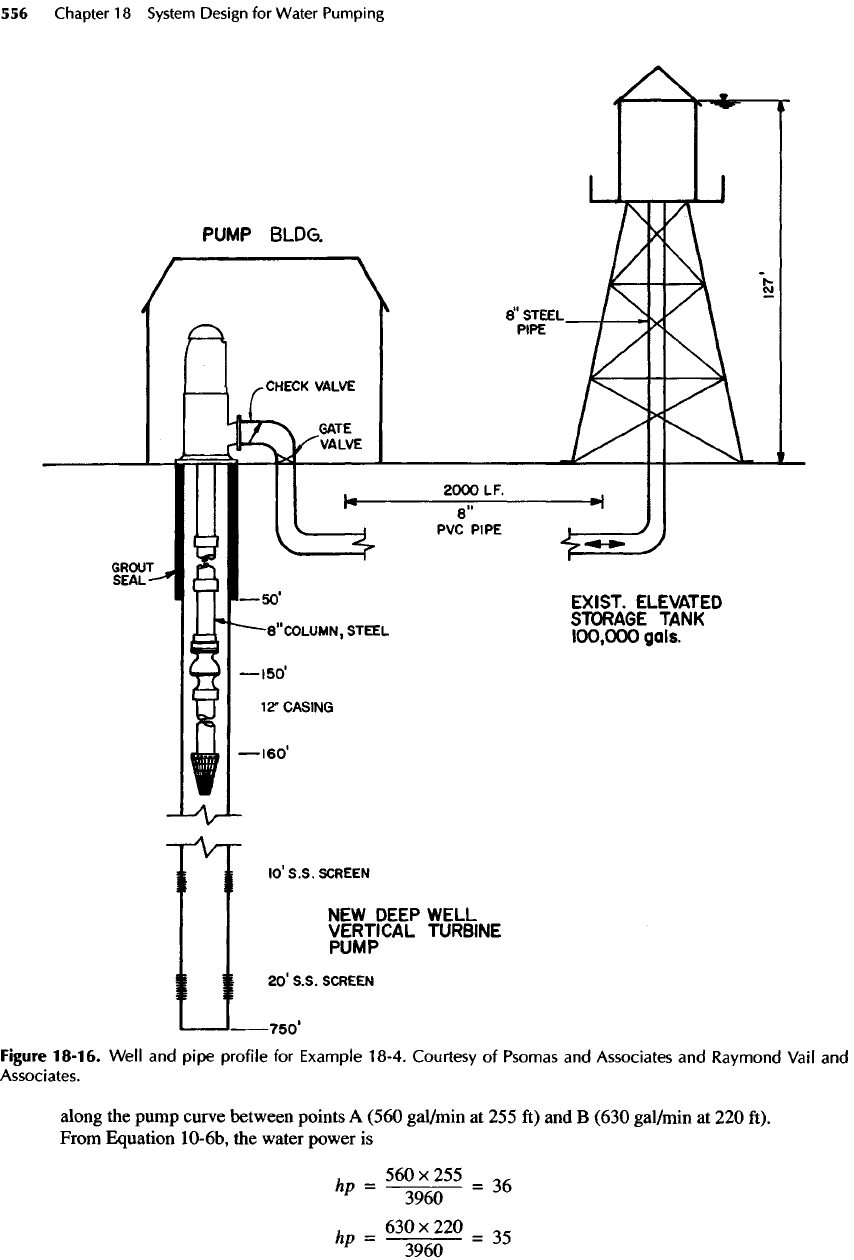
Figure
18-16. Well
and
pipe profile
for
Example
18-4.
Courtesy
of
Psomas
and
Associates
and
Raymond
Vail
and
Associates.
along
the
pump curve between points
A
(560
gal/min
at 255 ft) and B
(630
gal/min
at 220
ft).
From Equation 10-6b,
the
water power
is
"-^iSF-"
„.«»*».*
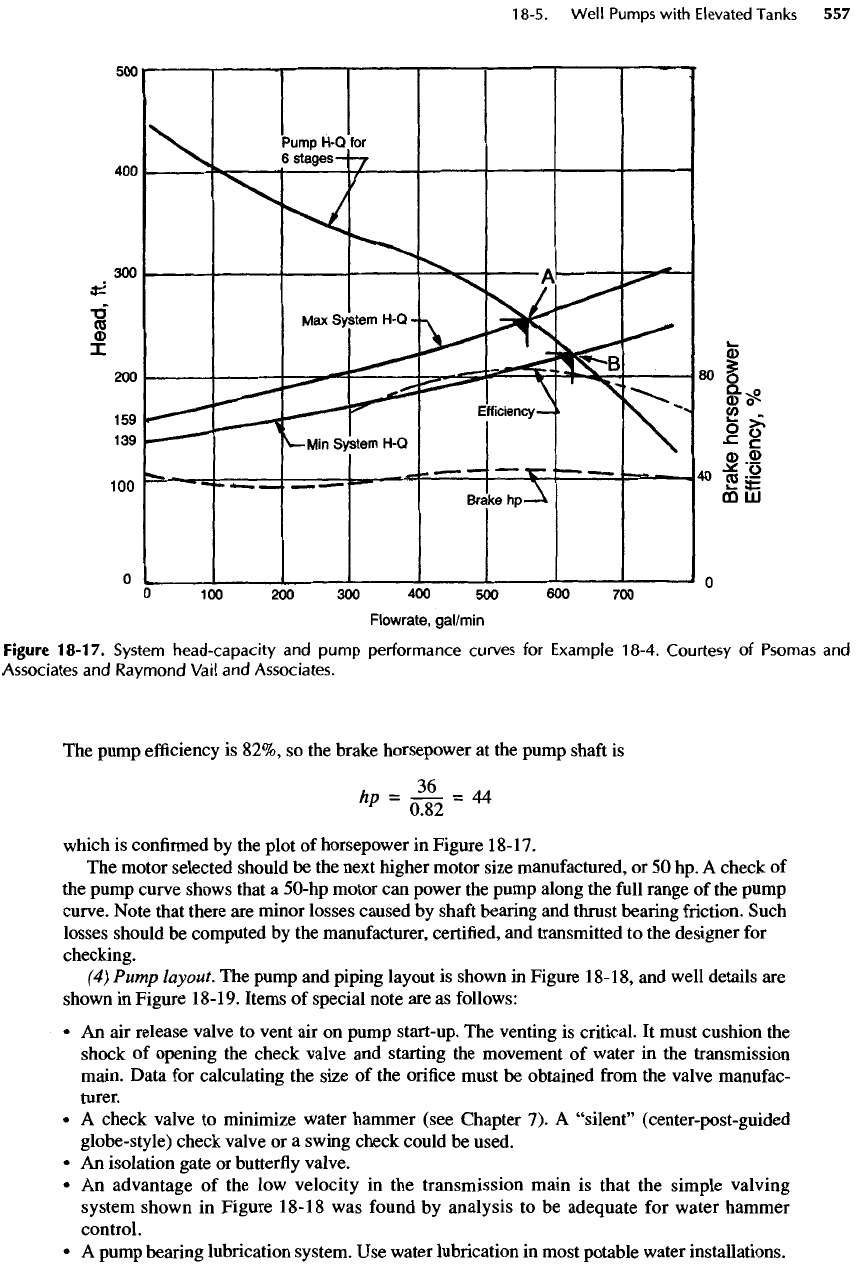
Figure
18-17.
System
head-capacity
and
pump
performance
curves
for
Example
18-4.
Courtesy
of
Psomas
and
Associates
and
Raymond
Vail
and
Associates.
The
pump
efficiency
is
82%,
so the
brake horsepower
at the
pump
shaft
is
,
36
AA
hp
=
082
=
"
which
is
confirmed
by the
plot
of
horsepower
in
Figure
18-17.
The
motor selected should
be the
next higher motor size manufactured,
or 50 hp. A
check
of
the
pump curve shows that
a
50-hp
motor
can
power
the
pump along
the
full
range
of the
pump
curve.
Note that there
are
minor losses caused
by
shaft
bearing
and
thrust bearing friction. Such
losses should
be
computed
by the
manufacturer, certified,
and
transmitted
to the
designer
for
checking.
(4)
Pump layout.
The
pump
and
piping layout
is
shown
in
Figure
18-18,
and
well details
are
shown
in
Figure
18-19.
Items
of
special note
are as
follows:
• An air
release valve
to
vent
air on
pump start-up.
The
venting
is
critical.
It
must cushion
the
shock
of
opening
the
check valve
and
starting
the
movement
of
water
in the
transmission
main.
Data
for
calculating
the
size
of the
orifice must
be
obtained
from
the
valve manufac-
turer.
• A
check valve
to
minimize water hammer (see Chapter
7). A
"silent"
(center-post-guided
globe-style) check valve
or a
swing check could
be
used.
• An
isolation gate
or
butterfly
valve.
• An
advantage
of the low
velocity
in the
transmission main
is
that
the
simple valving
system shown
in
Figure
18-18
was
found
by
analysis
to be
adequate
for
water hammer
control.
• A
pump bearing lubrication system.
Use
water lubrication
in
most potable water installations.
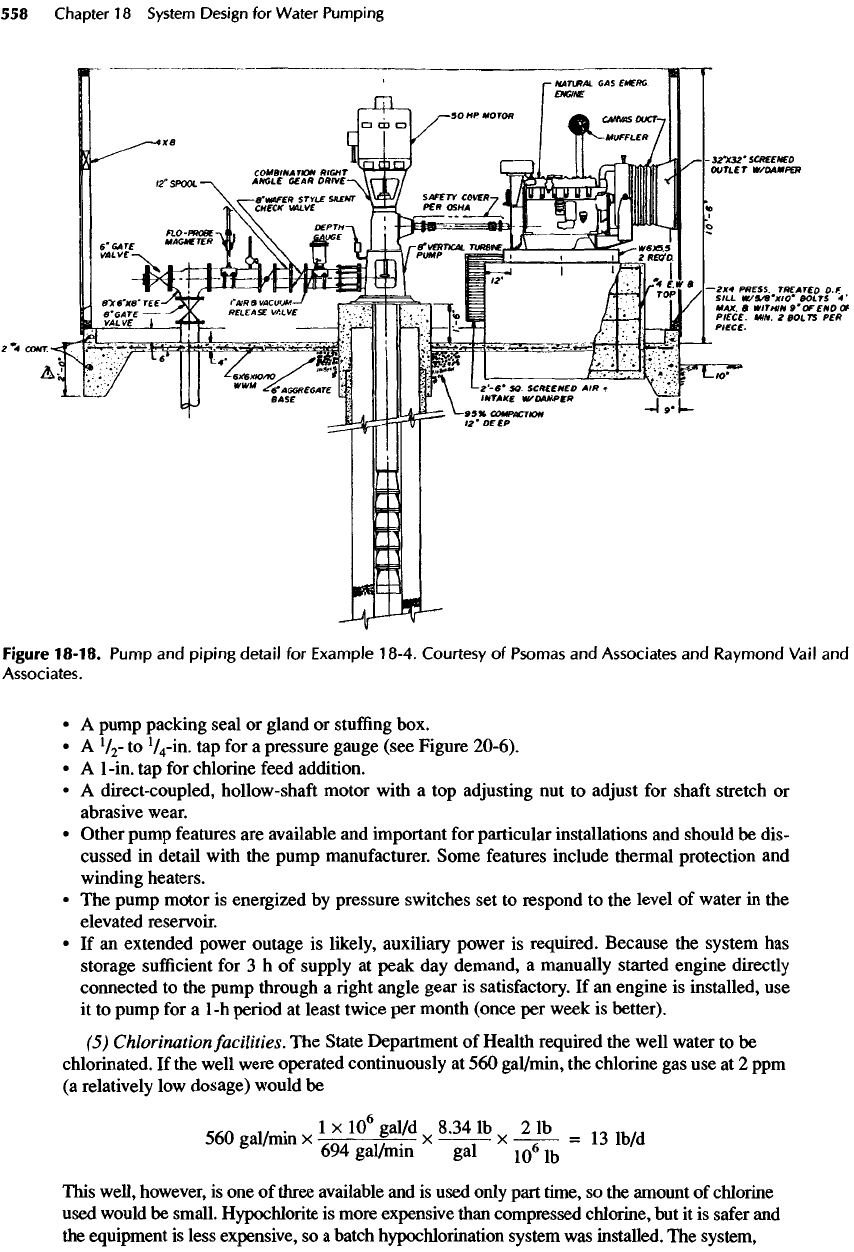
Figure
18-18.
Pump
and
piping
detail
for
Example
18-4.
Courtesy
of
Psomas
and
Associates
and
Raymond
Vail
and
Associates.
• A
pump packing seal
or
gland
or
stuffing
box.
• A
1
I
2
-
to
1
I
4
-In.
tap for a
pressure gauge (see Figure 20-6).
• A
1-in.
tap for
chlorine
feed
addition.
• A
direct-coupled, hollow-shaft motor with
a top
adjusting
nut to
adjust
for
shaft
stretch
or
abrasive wear.
•
Other pump features
are
available
and
important
for
particular installations
and
should
be
dis-
cussed
in
detail with
the
pump manufacturer. Some features include thermal protection
and
winding
heaters.
• The
pump motor
is
energized
by
pressure switches
set to
respond
to the
level
of
water
in the
elevated reservoir.
• If an
extended power outage
is
likely, auxiliary power
is
required. Because
the
system
has
storage
sufficient
for 3 h of
supply
at
peak
day
demand,
a
manually started engine directly
connected
to the
pump through
a right
angle gear
is
satisfactory.
If an
engine
is
installed,
use
it
to
pump
for a
1-h
period
at
least twice
per
month (once
per
week
is
better).
(5)
Chlorination
facilities.
The
State Department
of
Health required
the
well water
to be
chlorinated.
If the
well were
operated
continuously
at 560
gal/min,
the
chlorine
gas use at 2 ppm
(a
relatively
low
dosage) would
be
-^
n
17
. 1 x
IQ
6
gal/d
8.34
Ib
2
Ib
_
„.,
560
gal/mm
x
-——-f-f-
x
— x
—-—
= 13
Ib/d
&
694
gal/mm
gal
10
6
I
D
This
well, however,
is one of
three available
and is
used only part time,
so the
amount
of
chlorine
used
would
be
small.
Hypochlorite
is
more expensive than compressed chlorine,
but it is
safer
and
the
equipment
is
less expensive,
so a
batch
hypochlorination
system
was
installed.
The
system,
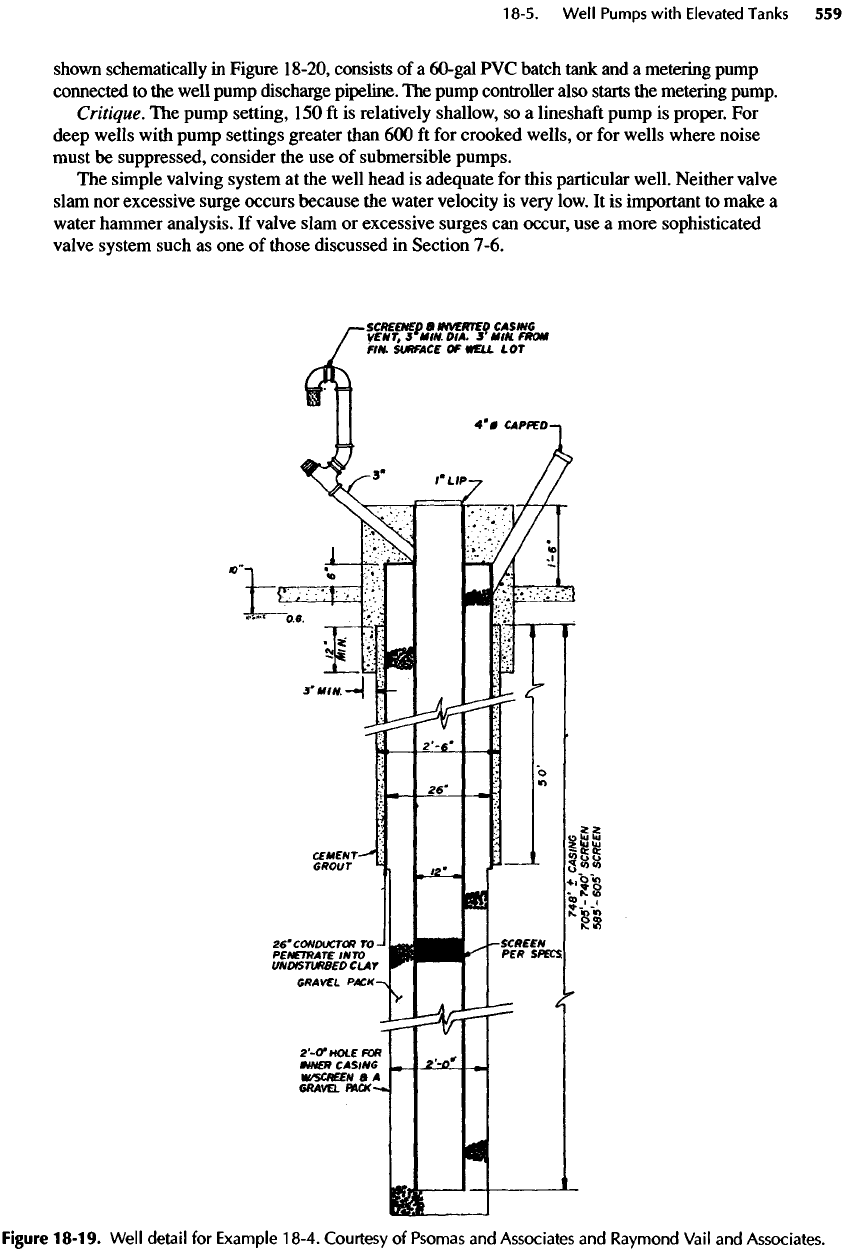
shown
schematically
in
Figure
18-20,
consists
of a
60-gal
PVC
batch tank
and a
metering pump
connected
to the
well pump
discharge
pipeline.
Hie
pump controller also starts
the
metering pump.
Critique.
The
pump setting,
150 ft is
relatively shallow,
so a
lineshaft
pump
is
proper.
For
deep wells with pump settings greater than
600 ft for
crooked wells,
or for
wells where noise
must
be
suppressed, consider
the use of
submersible pumps.
The
simple valving system
at the
well head
is
adequate
for
this particular well. Neither valve
slam
nor
excessive surge occurs because
the
water velocity
is
very low.
It is
important
to
make
a
water
hammer analysis.
If
valve slam
or
excessive surges
can
occur,
use a
more sophisticated
valve
system such
as one of
those discussed
in
Section
7-6.
Figure
18-19.
Well detail
for
Example
18-4.
Courtesy
of
Psomas
and
Associates
and
Raymond
Vail
and
Associates.
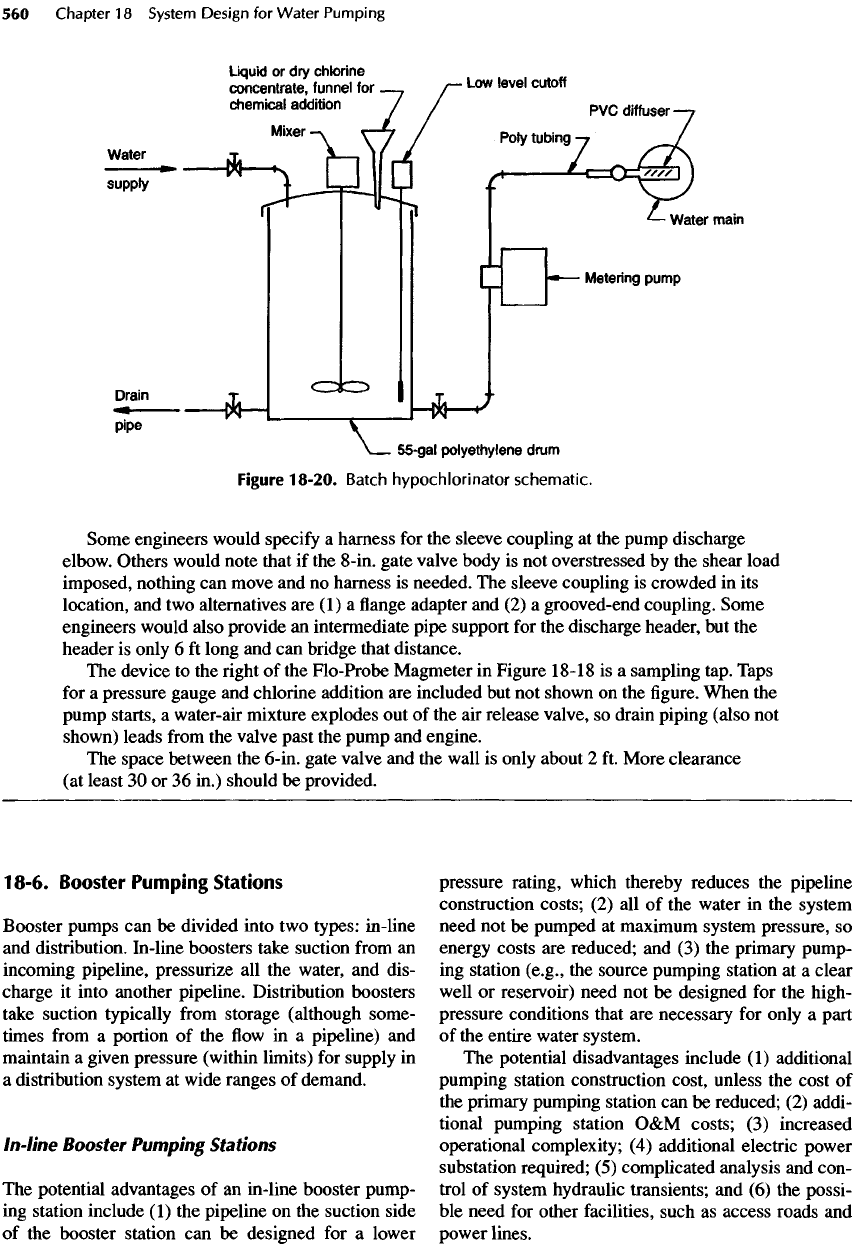
1
8-6.
Booster
Pumping
Stations
Booster pumps
can be
divided into
two
types: in-line
and
distribution. In-line boosters take suction
from
an
incoming
pipeline, pressurize
all the
water,
and
dis-
charge
it
into another
pipeline.
Distribution boosters
take
suction typically
from
storage (although some-
times
from
a
portion
of the flow in a
pipeline)
and
maintain
a
given pressure (within limits)
for
supply
in
a
distribution system
at
wide ranges
of
demand.
In-line
Booster
Pumping
Stations
The
potential advantages
of an
in-line
booster
pump-
ing
station include
(1)
the
pipeline
on the
suction side
of
the
booster station
can be
designed
for a
lower
pressure rating, which thereby reduces
the
pipeline
construction costs;
(2) all of the
water
in the
system
need
not be
pumped
at
maximum system pressure,
so
energy
costs
are
reduced;
and (3) the
primary pump-
ing
station
(e.g.,
the
source pumping station
at a
clear
well
or
reservoir) need
not be
designed
for the
high-
pressure conditions that
are
necessary
for
only
a
part
of
the
entire water system.
The
potential disadvantages include
(1)
additional
pumping
station construction cost, unless
the
cost
of
the
primary pumping station
can be
reduced;
(2)
addi-
tional pumping station
O&M
costs;
(3)
increased
operational complexity;
(4)
additional electric power
substation
required;
(5)
complicated analysis
and
con-
trol
of
system hydraulic
transients;
and (6) the
possi-
ble
need
for
other facilities, such
as
access roads
and
power lines.
Figure
18-20.
Batch
hypochlorinator
schematic.
Some engineers would specify
a
harness
for the
sleeve coupling
at the
pump discharge
elbow. Others would note that
if the
8-in.
gate valve body
is not
overstressed
by the
shear load
imposed, nothing
can
move
and no
harness
is
needed.
The
sleeve coupling
is
crowded
in its
location,
and two
alternatives
are
(1)
a
flange
adapter
and (2) a
grooved-end coupling. Some
engineers would also provide
an
intermediate pipe support
for the
discharge header,
but the
header
is
only
6 ft
long
and can
bridge that distance.
The
device
to the
right
of the
Flo-Probe
Magmeter
in
Figure
18-18
is a
sampling
tap.
Taps
for
a
pressure gauge
and
chlorine addition
are
included
but not
shown
on the
figure.
When
the
pump
starts,
a
water-air mixture explodes
out of the air
release valve,
so
drain piping (also
not
shown)
leads
from
the
valve past
the
pump
and
engine.
The
space between
the
6-in.
gate valve
and the
wall
is
only about
2 ft.
More clearance
(at
least
30 or 36
in.)
should
be
provided.
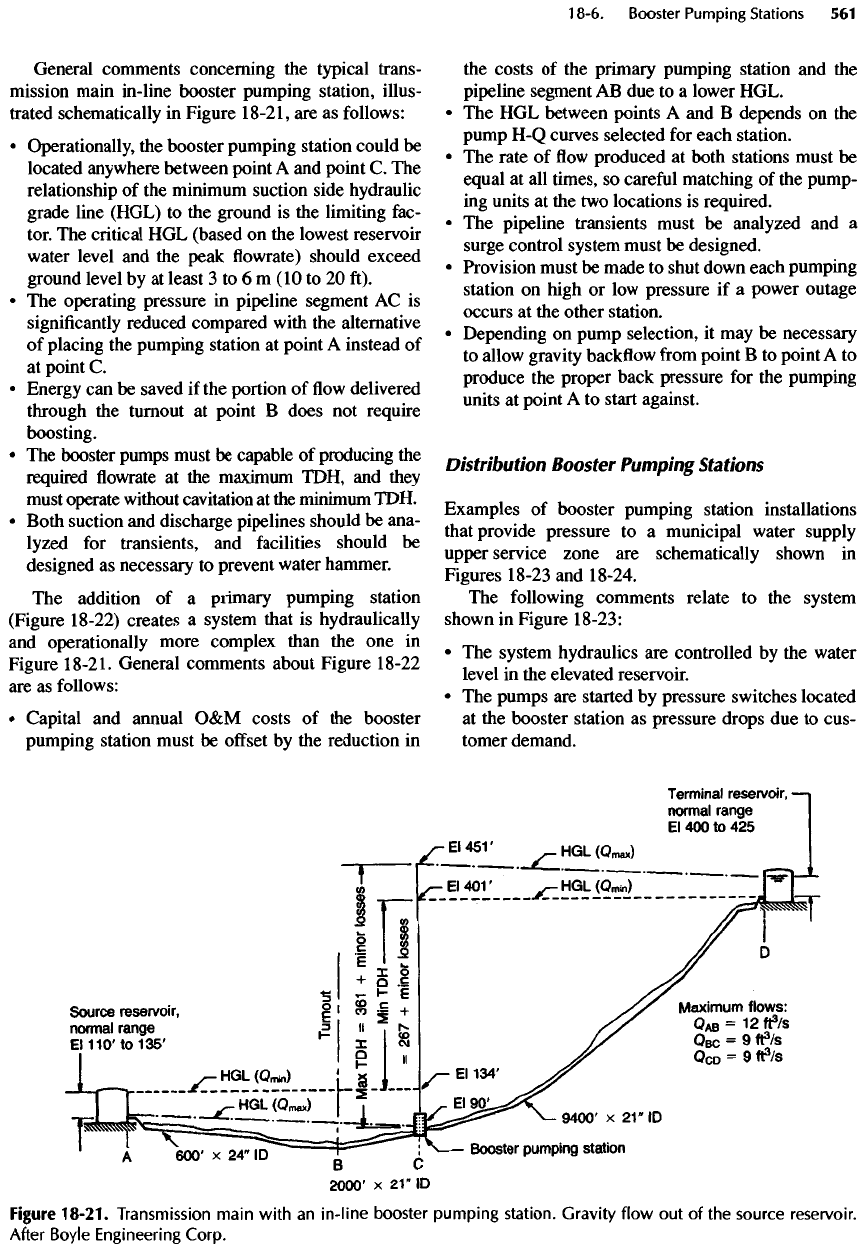
General comments concerning
the
typical trans-
mission main in-line
booster
pumping station, illus-
trated schematically
in
Figure
18-21,
are as
follows:
•
Operationally,
the
booster
pumping station could
be
located anywhere between point
A and
point
C. The
relationship
of the
minimum suction side hydraulic
grade
line (HGL)
to the
ground
is the
limiting fac-
tor.
The
critical
HGL
(based
on the
lowest reservoir
water
level
and the
peak
flowrate)
should
exceed
ground
level
by at
least
3 to 6 m (10 to 20 ft).
• The
operating pressure
in
pipeline segment
AC is
significantly
reduced compared with
the
alternative
of
placing
the
pumping station
at
point
A
instead
of
at
point
C.
•
Energy
can be
saved
if the
portion
of flow
delivered
through
the
turnout
at
point
B
does
not
require
boosting.
• The
booster pumps must
be
capable
of
producing
the
required
flowrate at the
maximum TDH,
and
they
must
operate
without
cavitation
at the
minimum TDH.
•
Both suction
and
discharge pipelines should
be
ana-
lyzed
for
transients,
and
facilities should
be
designed
as
necessary
to
prevent water hammer.
The
addition
of a
primary pumping station
(Figure 18-22) creates
a
system that
is
hydraulically
and
operationally more complex than
the one in
Figure
18-21.
General comments about Figure 18-22
are as
follows:
•
Capital
and
annual
O&M
costs
of the
booster
pumping
station must
be
offset
by the
reduction
in
the
costs
of the
primary pumping station
and the
pipeline segment
AB due to a
lower HGL.
• The HGL
between points
A and B
depends
on the
pump
H-Q
curves
selected
for
each station.
• The
rate
of flow
produced
at
both stations must
be
equal
at all
times,
so
careful
matching
of the
pump-
ing
units
at the two
locations
is
required.
• The
pipeline transients must
be
analyzed
and a
surge
control system must
be
designed.
•
Provision must
be
made
to
shut down each pumping
station
on
high
or low
pressure
if a
power outage
occurs
at the
other station.
•
Depending
on
pump selection,
it may be
necessary
to
allow gravity
backflow
from
point
B to
point
A to
produce
the
proper back pressure
for the
pumping
units
at
point
A to
start against.
Distribution
Booster
Pumping
Stations
Examples
of
booster pumping station installations
that
provide pressure
to a
municipal water supply
upper service zone
are
schematically shown
in
Figures 18-23
and
18-24.
The
following comments relate
to the
system
shown
in
Figure
18-23:
• The
system hydraulics
are
controlled
by the
water
level
in the
elevated
reservoir.
• The
pumps
are
started
by
pressure switches
located
at
the
booster station
as
pressure drops
due to
cus-
tomer demand.
Figure
18-21.
Transmission
main
with
an
in-line
booster
pumping
station.
Gravity
flow
out of the
source
reservoir.
After
Boyle
Engineering
Corp.
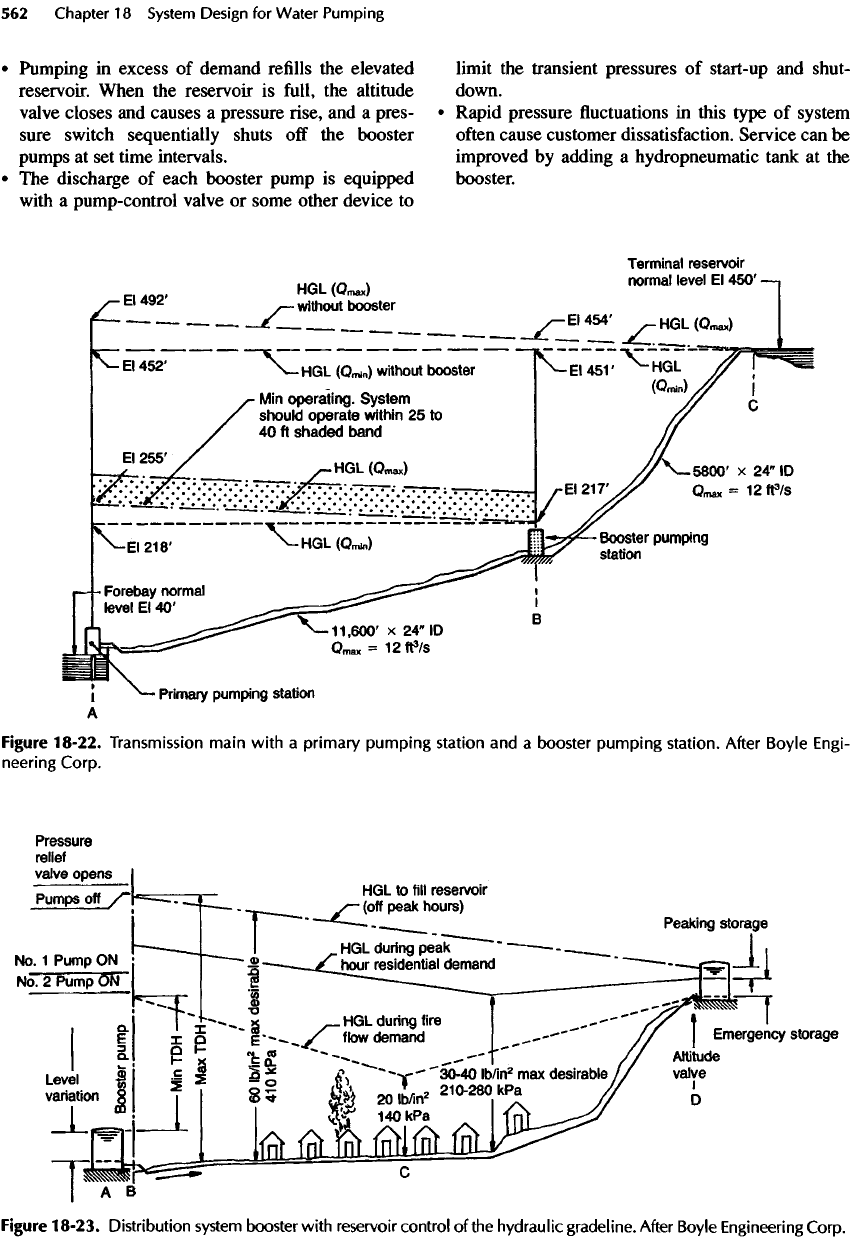
•
Pumping
in
excess
of
demand
refills
the
elevated
reservoir. When
the
reservoir
is
full,
the
altitude
valve
closes
and
causes
a
pressure rise,
and a
pres-
sure
switch sequentially shuts
off the
booster
pumps
at set
time intervals.
• The
discharge
of
each
booster
pump
is
equipped
with
a
pump-control valve
or
some other device
to
limit
the
transient pressures
of
start-up
and
shut-
down.
•
Rapid pressure
fluctuations in
this type
of
system
often
cause customer dissatisfaction. Service
can be
improved
by
adding
a
hydropneumatic tank
at the
booster.
Figure
18-22.
Transmission
main
with
a
primary
pumping
station
and a
booster
pumping
station. After Boyle Engi-
neering Corp.
Figure
18-23.
Distribution
system
booster
with
reservoir
control
of the
hydraulic gradeline.
After
Boyle Engineering Corp.
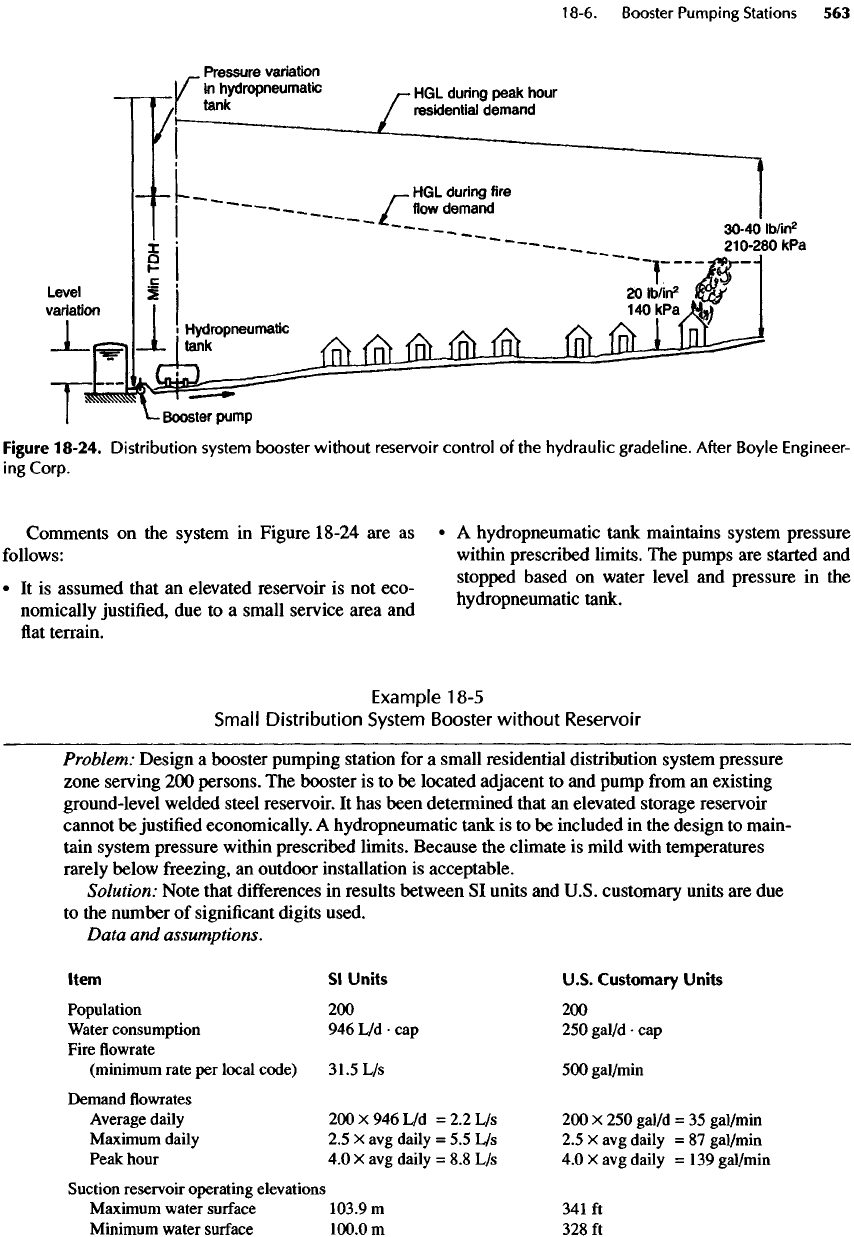
Comments
on the
system
in
Figure
18-24
are as
follows:
• It is
assumed that
an
elevated reservoir
is not
eco-
nomically
justified,
due to a
small service area
and
flat
terrain.
• A
hydropneumatic tank maintains system pressure
within
prescribed limits.
The
pumps
are
started
and
stopped based
on
water level
and
pressure
in the
hydropneumatic tank.
Figure
18-24.
Distribution
system
booster
without
reservoir control
of the
hydraulic
gradeline. After Boyle Engineer-
ing
Corp.
Example
18-5
Small
Distribution
System
Booster
without
Reservoir
Problem:
Design
a
booster pumping station
for a
small residential distribution system pressure
zone serving
200
persons.
The
booster
is to be
located adjacent
to and
pump
from an
existing
ground-level welded steel reservoir.
It has
been determined that
an
elevated storage reservoir
cannot
be
justified
economically.
A
hydropneumatic tank
is to be
included
in the
design
to
main-
tain
system pressure within prescribed limits. Because
the
climate
is
mild with temperatures
rarely
below freezing,
an
outdoor installation
is
acceptable.
Solution:
Note that
differences
in
results between
SI
units
and
U.S. customary units
are due
to the
number
of
significant
digits used.
Data
and
assumptions.
Item
Sl
Units U.S. Customary Units
Population
200 200
Water
consumption
946 L/d • cap 250
gal/d
• cap
Fire
flowrate
(minimum
rate
per
local
code)
31.5
L/s 500
gal/min
Demand
flowrates
Average
daily
200 X 946 L/d = 2.2 L/s 200 X 250
gal/d
= 35
gal/min
Maximum
daily
2.5 X avg
daily
= 5.5 L/s 2.5 X avg
daily
= 87
gal/min
Peak hour
4.0 X avg
daily
= 8.8 L/s 4.0 X avg
daily
= 139
gal/min
Suction reservoir operating elevations
Maximum
water surface
103.9
m
341
ft
Minimum
water surface
100.0
m 328 ft
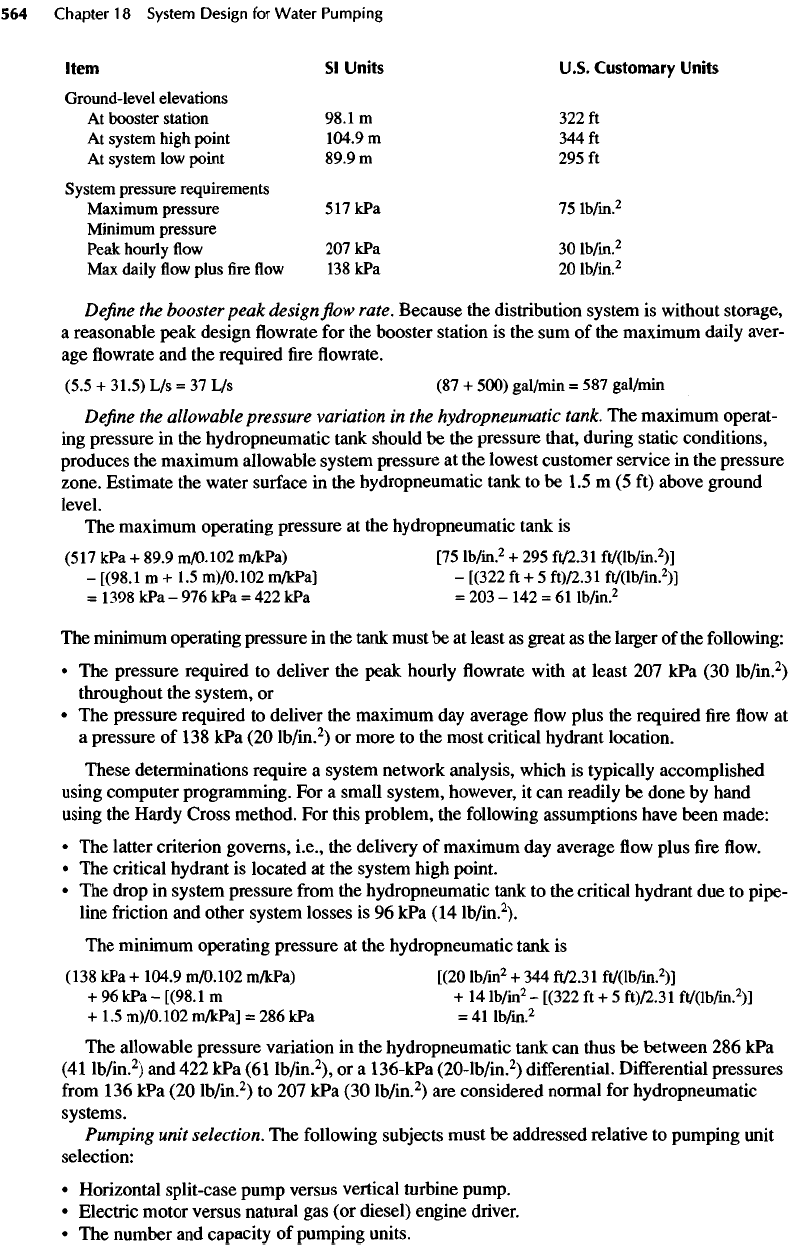
Item
SI
Units
U.S.
Customary
Units
Ground-level
elevations
At
booster
station
98.1
m 322 ft
At
system high
point
104.9
m 344 ft
At
system
low
point
89.9
m 295 ft
System
pressure
requirements
Maximum
pressure
517kPa
75
lb/in.
2
Minimum
pressure
Peak
hourly
flow 207
kPa
30
lb/in.
2
Max
daily
flow
plus
fire flow 138 kPa 20
lb/in.
2
Define
the
booster peak
design
flow
rate. Because
the
distribution system
is
without storage,
a
reasonable peak design
flowrate for the
booster station
is the sum of the
maximum daily aver-
age
flowrate and the
required
fire flowrate.
(5.5
+
31.5)
L/s = 37 L/s (87 +
500)
gal/min
= 587
gal/min
Define
the
allowable
pressure variation
in the
hydropneumatic
tank.
The
maximum operat-
ing
pressure
in the
hydropneumatic tank should
be the
pressure that, during static conditions,
produces
the
maximum allowable system pressure
at the
lowest customer service
in the
pressure
zone. Estimate
the
water surface
in the
hydropneumatic tank
to be 1.5 m (5 ft)
above ground
level.
The
maximum operating pressure
at the
hydropneumatic tank
is
(517
kPa +
89.9
m/0.102
m/kPa)
[75
lb/in.
2
+ 295
ft/2.31
ft/(lb/in.
2
)]
-
[(98.1
m
-»-1.5
m)/0.102
m/kPa]
-
[(322
ft
+ 5
ft)/2.31
fV(lb/in.
2
)]
=
1398
kPa
- 976 kPa = 422 kPa = 203 - 142 = 61
lb/in.
2
The
minimum operating pressure
in the
tank must
be at
least
as
great
as the
larger
of the
following:
• The
pressure required
to
deliver
the
peak hourly
flowrate
with
at
least
207 kPa (30
lb/in.
2
)
throughout
the
system,
or
• The
pressure required
to
deliver
the
maximum
day
average
flow
plus
the
required
fire flow at
a
pressure
of 138 kPa (20
lb/in.
2
)
or
more
to the
most critical hydrant location.
These determinations require
a
system network analysis, which
is
typically accomplished
using
computer programming.
For a
small system, however,
it can
readily
be
done
by
hand
using
the
Hardy Cross method.
For
this problem,
the
following assumptions have been made:
• The
latter criterion governs, i.e.,
the
delivery
of
maximum
day
average
flow
plus
fire flow.
• The
critical hydrant
is
located
at the
system high point.
• The
drop
in
system pressure
from
the
hydropneumatic tank
to the
critical
hydrant
due to
pipe-
line friction
and
other system losses
is 96 kPa
(14
lb/in.
2
).
The
minimum operating pressure
at the
hydropneumatic tank
is
(138
kPa +
104.9
m/0.102
m/kPa)
[(2O
lb/in
2
+ 344
ft/2.31
ft/Ob/in.
2
)]
+
96
kPa
-
[(98.
Im
+14
lb/in
2
-
[(322
ft
+ 5
ft)/2.31
ft/(lb/in.
2
)]
+
1.5
m)/0.102
m/kPa]
= 286 kPa = 41
lb/in.
2
The
allowable pressure variation
in the
hydropneumatic tank
can
thus
be
between
286 kPa
(41
lb/in.
2
)
and 422 kPa
(61
lb/in.
2
),
or a
136-kPa
(20-lb/in.
2
)
differential. Differential pressures
from
136
kPa (20
lb/in.
2
)
to 207 kPa (30
lb/in.
2
)
are
considered normal
for
hydropneumatic
systems.
Pumping
unit selection.
The
following subjects must
be
addressed relative
to
pumping unit
selection:
•
Horizontal split-case pump versus vertical turbine pump.
•
Electric motor versus natural
gas (or
diesel) engine driver.
• The
number
and
capacity
of
pumping units.
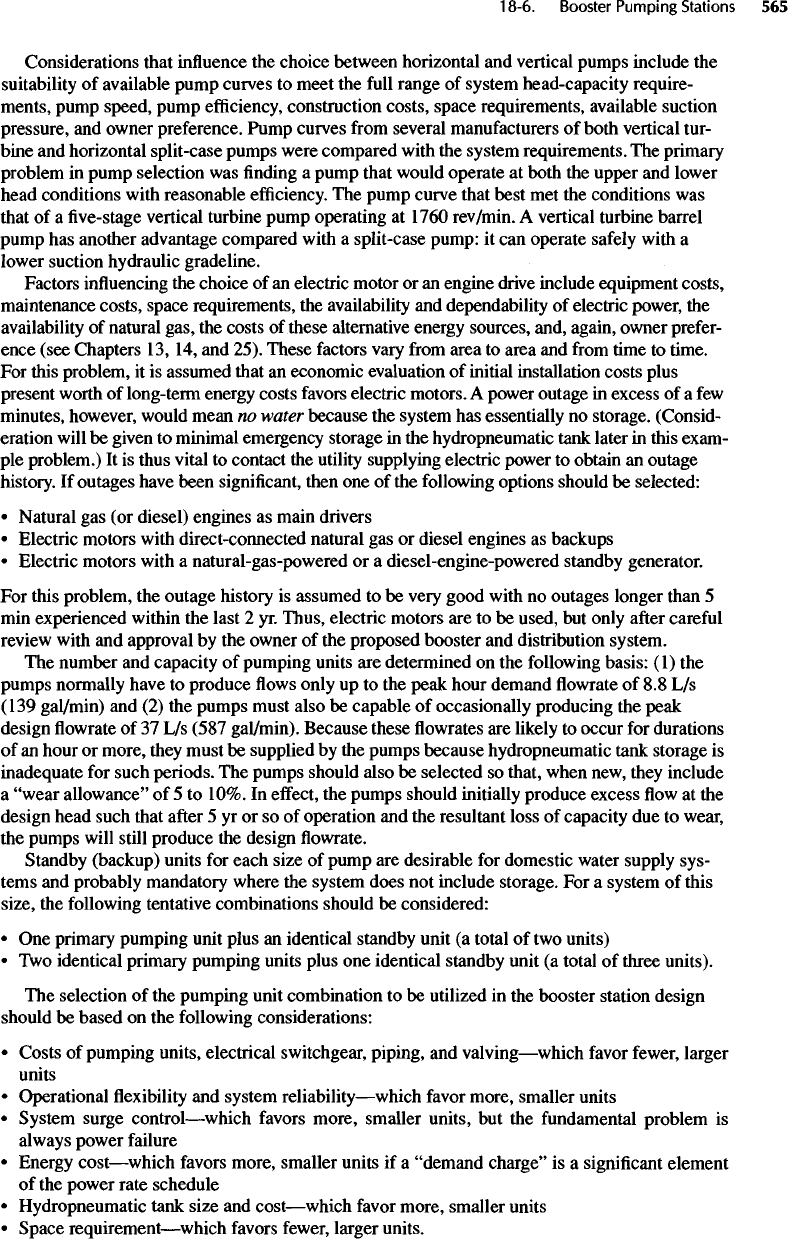
Considerations that
influence
the
choice between horizontal
and
vertical pumps include
the
suitability
of
available pump curves
to
meet
the
full
range
of
system head-capacity require-
ments, pump speed, pump
efficiency,
construction
costs,
space requirements, available suction
pressure,
and
owner preference. Pump curves
from
several manufacturers
of
both vertical tur-
bine
and
horizontal
split-case
pumps were compared with
the
system requirements.
The
primary
problem
in
pump selection
was
finding
a
pump that would operate
at
both
the
upper
and
lower
head conditions with reasonable
efficiency.
The
pump curve that best
met the
conditions
was
that
of a five-stage
vertical turbine pump operating
at
1760 rev/min.
A
vertical turbine barrel
pump
has
another advantage compared with
a
split-case pump:
it can
operate
safely
with
a
lower suction hydraulic gradeline.
Factors
influencing
the
choice
of an
electric motor
or an
engine drive include equipment costs,
maintenance
costs, space requirements,
the
availability
and
dependability
of
electric power,
the
availability
of
natural gas,
the
costs
of
these alternative energy sources, and, again, owner prefer-
ence (see Chapters
13,14,
and
25). These factors
vary
from
area
to
area
and
from
time
to
time.
For
this problem,
it is
assumed that
an
economic evaluation
of
initial installation costs plus
present worth
of
long-term energy costs
favors
electric
motors.
A
power outage
in
excess
of a few
minutes,
however, would mean
no
water
because
the
system
has
essentially
no
storage. (Consid-
eration will
be
given
to
minimal emergency storage
in the
hydropneumatic tank later
in
this exam-
ple
problem.)
It is
thus vital
to
contact
the
utility supplying electric power
to
obtain
an
outage
history.
If
outages have been significant, then
one of the
following options should
be
selected:
•
Natural
gas (or
diesel) engines
as
main drivers
•
Electric motors with direct-connected natural
gas or
diesel
engines
as
backups
•
Electric motors with
a
natural-gas-powered
or a
diesel-engine-powered standby generator.
For
this problem,
the
outage history
is
assumed
to be
very good with
no
outages longer than
5
min
experienced within
the
last
2 yr.
Thus,
electric
motors
are to be
used,
but
only
after
careful
review
with
and
approval
by the
owner
of the
proposed booster
and
distribution system.
The
number
and
capacity
of
pumping units
are
determined
on the
following basis:
(1) the
pumps
normally have
to
produce
flows
only
up to the
peak hour demand
flowrate of 8.8 L/s
(139
gal/min)
and (2) the
pumps must also
be
capable
of
occasionally producing
the
peak
design
flowrate of 37 L/s
(587 gal/min). Because these
flowrates are
likely
to
occur
for
durations
of
an
hour
or
more, they must
be
supplied
by the
pumps because hydropneumatic tank storage
is
inadequate
for
such
periods.
The
pumps should also
be
selected
so
that, when new, they include
a
"wear
allowance"
of 5 to
10%.
In
effect,
the
pumps should initially produce excess
flow at the
design head such that
after
5 yr or so of
operation
and the
resultant loss
of
capacity
due to
wear,
the
pumps
will
still produce
the
design
flowrate.
Standby
(backup) units
for
each size
of
pump
are
desirable
for
domestic water supply sys-
tems
and
probably mandatory where
the
system does
not
include storage.
For a
system
of
this
size,
the
following tentative combinations should
be
considered:
• One
primary pumping unit plus
an
identical standby unit
(a
total
of two
units)
• Two
identical
primary pumping units plus
one
identical standby unit
(a
total
of
three units).
The
selection
of the
pumping unit combination
to be
utilized
in the
booster
station design
should
be
based
on the
following considerations:
•
Costs
of
pumping units, electrical switchgear, piping,
and
valving—which
favor
fewer,
larger
units
•
Operational
flexibility and
system
reliability—which
favor
more, smaller units
•
System surge
control—which
favors
more, smaller units,
but the
fundamental problem
is
always
power
failure
•
Energy
cost—which
favors
more, smaller units
if a
"demand charge"
is a
significant
element
of
the
power rate schedule
•
Hydropneumatic tank size
and
cost—which
favor
more, smaller units
•
Space
requirement—which
favors
fewer,
larger units.
